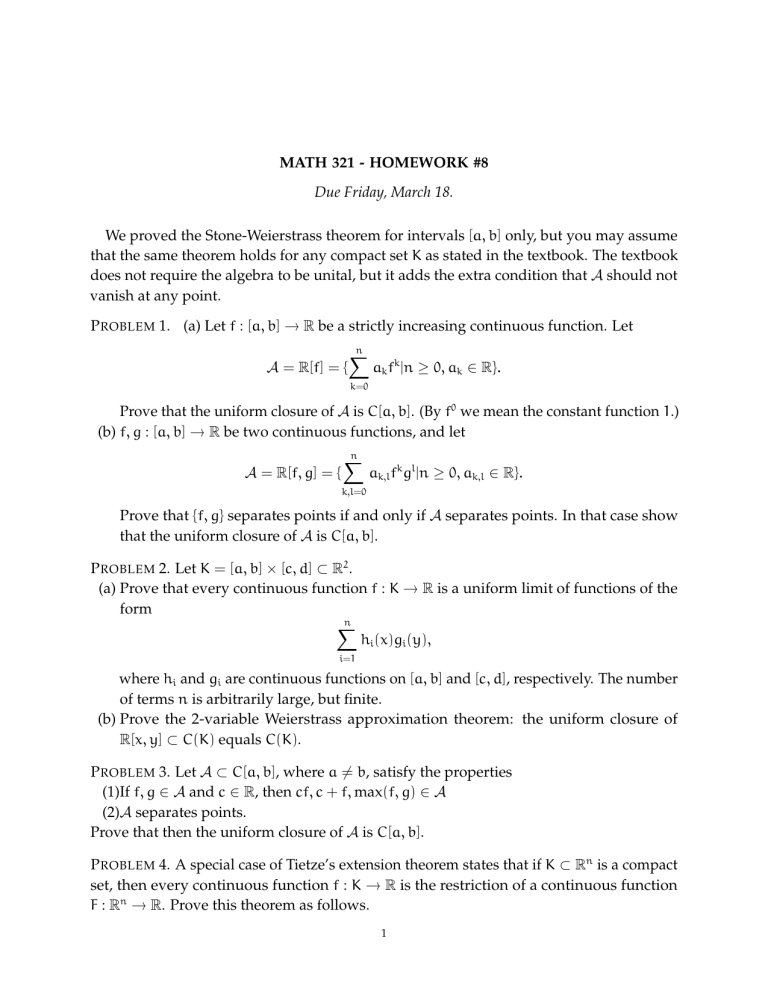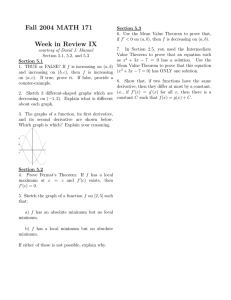MATH 321 - HOMEWORK #8 Due Friday, March 18.
advertisement

MATH 321 - HOMEWORK #8
Due Friday, March 18.
We proved the Stone-Weierstrass theorem for intervals [a, b] only, but you may assume
that the same theorem holds for any compact set K as stated in the textbook. The textbook
does not require the algebra to be unital, but it adds the extra condition that A should not
vanish at any point.
P ROBLEM 1. (a) Let f : [a, b] → R be a strictly increasing continuous function. Let
A = R[f] = {
n
X
ak fk |n ≥ 0, ak ∈ R}.
k=0
Prove that the uniform closure of A is C[a, b]. (By f0 we mean the constant function 1.)
(b) f, g : [a, b] → R be two continuous functions, and let
A = R[f, g] = {
n
X
ak,l fk gl |n ≥ 0, ak,l ∈ R}.
k,l=0
Prove that {f, g} separates points if and only if A separates points. In that case show
that the uniform closure of A is C[a, b].
P ROBLEM 2. Let K = [a, b] × [c, d] ⊂ R2 .
(a) Prove that every continuous function f : K → R is a uniform limit of functions of the
form
n
X
hi (x)gi (y),
i=1
where hi and gi are continuous functions on [a, b] and [c, d], respectively. The number
of terms n is arbitrarily large, but finite.
(b) Prove the 2-variable Weierstrass approximation theorem: the uniform closure of
R[x, y] ⊂ C(K) equals C(K).
P ROBLEM 3. Let A ⊂ C[a, b], where a 6= b, satisfy the properties
(1)If f, g ∈ A and c ∈ R, then cf, c + f, max(f, g) ∈ A
(2)A separates points.
Prove that then the uniform closure of A is C[a, b].
P ROBLEM 4. A special case of Tietze’s extension theorem states that if K ⊂ Rn is a compact
set, then every continuous function f : K → R is the restriction of a continuous function
F : Rn → R. Prove this theorem as follows.
1
(a) Prove that every continuous function f can be uniformly approximated by restrictions
of continuous functions F. To do this, let A be the set of all functions K → R that are
restrictions of continuous functions Rn → R and apply Stone-Weierstrass theorem to
this A.
(b) If f is bounded by M, prove that the approximations F as in the previous part can
be chosen also bounded by M. You may assume that if F, G are continuous, then
min(F, G) and max(F, G) are also continuous.
(c) To prove Tietze’s theorem, start with f and choose the first approximation F1 , such
that |f(x) − F1 |C (x)| < for every x ∈ K. Now find an approximation F2 of the error
f − F1 |C , such that F2 is bounded by and F2 is 2 -close to f − F1 |C . Continue like this.
P
In the end, the sum Fi gives the correct function that restricts to f.
Tietze’s extension theorem is true more generally for any closed set K in any metric space.




